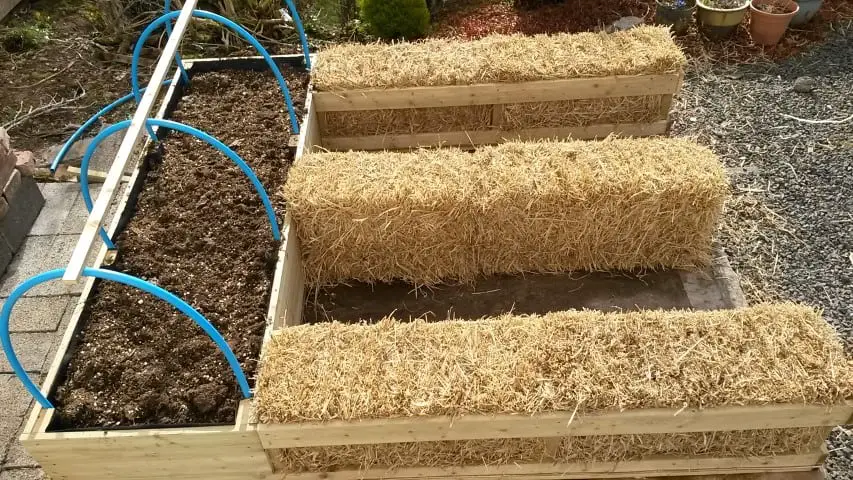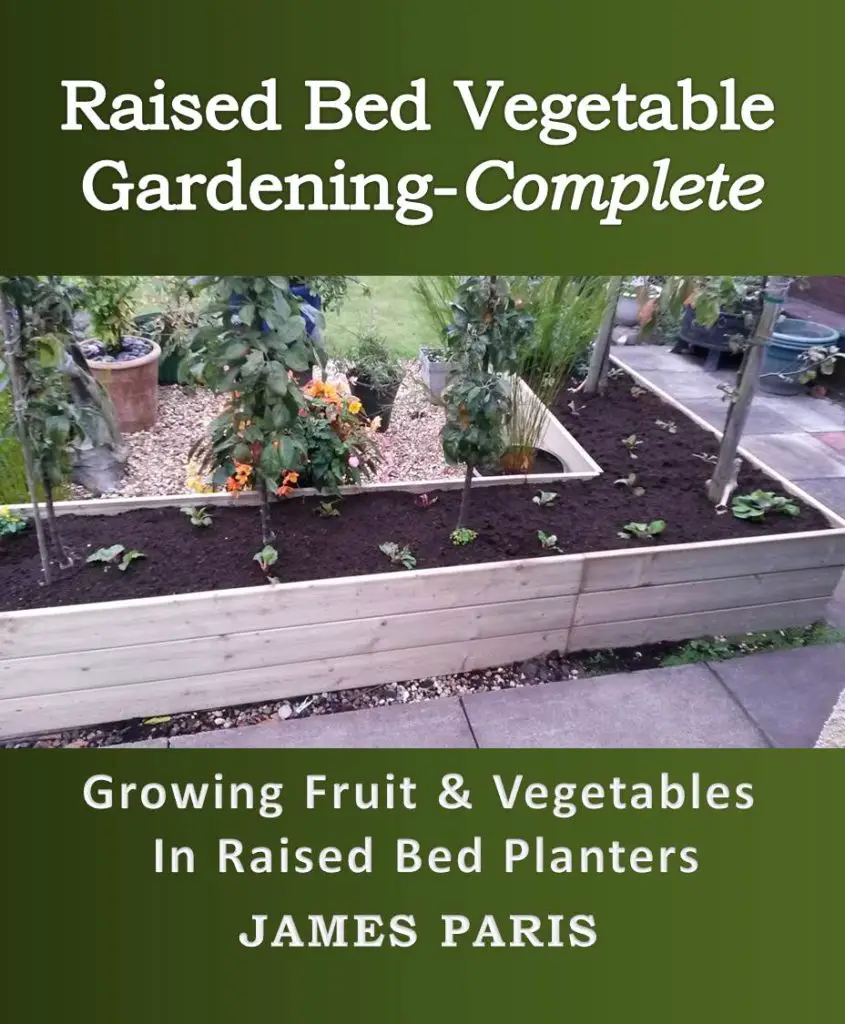For the vegetable gardener that is considering growing vegetables in raised beds rather than in-ground beds – also known as row gardening, there are a number of questions that have to be considered.
This is especially the case if you are considering growing vegetables for the first time, but even the experienced vegetable gardener may well be surprised at the scope and potential when using Raised Garden Beds.
As for the question of what is best between raised beds and in-ground gardening methods, then I have to say that Raised Beds win the contest easily!
To ‘put my cards on the table’ so to speak, I will admit right away that I am a firm advocate of Raised Bed gardening methods, so perhaps I am just a little biased! That said, I will try and be fair as I list the pros and cons (yes there are some) of Raised Bed gardening as well as compare these with in-ground methods.

The Pros of Raised Bed Gardening:
- Ease of use: The raised bed – especially the higher beds – are excellent to operate for anyone with back problems or other physical or age issues that make traditional gardening methods difficult or even impossible. No more knee pads needed with a high Raised Garden Bed – Harvesting crops is a simple matter of reaching over and helping yourself!
- Weed free? To a large extent the Raised Bed garden does not have the same weed problems that beset the in-ground method as the in-fill for the bed is not full of weed seeds at least for the first year of construction. After this period a few weeds may start to appear but are easily removed owing to the particular loose infill that the Raised Bed is made up off.
- Pest Control: The fact that the growing area is raised off the ground creates a natural barrier for creeping or crawling insects and vermin. It is also an easy matter to construct simple framing with butterfly net to keep birds and butterflies away from the veggies. With beds over 2 foot high there is also less need to worry about the carrot fly as it generally flies under the 2 foot high level.
- Aesthetically pleasing: Yes, a series of Raised Beds all lined up like solders is great to look at! Not only that but creating paths between the beds allows you to move through a weed-free area where you are not spreading weed seeds throughout your veggie plot!
- More abundant crops: Since you can grow plants closer together in a raised bed, owing to the fact that the soil is richer and you will not need to leave space for ‘walking & weeding’ the crops tend to be more fruitful in general.
- Use up poor quality land: Even if your soil is poor and the ground on a horrible slope full of stones, you can still grow your own vegetables in a Raised bed. The infill does not depend on your own soil, and the bed can be adjusted to allow for almost any degree of sloping ground – just look at the stepped gardening in the Himalayas and other mountainous regions.
- No heavy tools needed: This can be a huge saving as any traditional gardener knows, the cost of heavy tools or mechanical rotovators etc is always a major consideration. With raised beds all you need are a few hand tools as there is no heavy digging needed at all.
- Can be set up anywhere: Even for folks with no back yard and nowhere to plant their vegetables in the normal way, a Raised Bed system can be set up virtually anywhere – from a concrete slab to a roof top!
The Cons of Raised Garden Beds:
- Expensive to build? This is perhaps the biggest negative of Raised Beds. A typical construction of a bed 9 x 3 x 2 foot high made with 2” thick lumber comes in at around $80 depending on where you are located. Add to this the cost of the infill material – if you do not make your own compost – and you are looking at the best part of $130 on average. However this cost can be off-set considerably by following these tips on filling a deep bed. Keep in mind also that the cost of a 4 x 4 6 inch high bed is considerably cheaper in all respects.
- Nothing lasts forever: Yes it has to be said that the wooden structure – compared to steel beds – of the Raised Bed will not last forever – usually around 10 years or so depending on the type of timber used and your particular location.
- Not good for trees: Whilst this is debatable, I have to accept that trees overall need more room for their root structure and so would take a larger bed area. However even this point is wrong if you factor in the dwarf and miniature fruit trees that are now available in most garden centres.

The Pros of In-Ground gardening methods
- Cheaper start-up costs: If you already have good growing ground to begin with, then the traditional in-ground or row garden is definitely cheaper than the alternative gardening methods. However you will have the more expensive heavy tools to purchase including the mechanical equipment that may be needed – plus the cost of a shed or store to keep them in!
- Less restrictive: If you have an odd shaped garden area or just do not want to be restricted by the boundaries of Raised Bed construction, then the row gardening area might just be a better choice for you.
Raised Bed or In-ground garden?
As I warned you it looks like I have come out heavily on the side of the Raised Bed garden, but I hope you will agree it is not without good cause?
I have listed the pros and cons of both methods as much as I am able and to be honest, I could add even more to the pros of Raised beds – but that would just be ‘pushing the envelope’ a little I think!
The fact is that there is virtually nothing that can be grown in a traditional row garden that cannot be grown better and easier in a properly set up Raised Bed. This applies to deep tap-root vegetables as well as surface brassicas, and even climbers – just attach a framework to the timbers of the structure.
Material Volume Chart for a Raised Bed
| LENGTH (feet) | WIDTH (feet) | HEIGHT (inches) | VOLUME NEEDED cubic feet |
| 9 | 3 | 30 | 67.5 |
| 9 | 3 | 24 | 54 |
| 9 | 3 | 18 | 40.5 |
| 9 | 3 | 12 | 27 |
| 6 | 3 | 30 | 45 |
| 6 | 3 | 24 | 36 |
| 6 | 3 | 18 | 27 |
| 6 | 3 | 12 | 18 |
| 4 | 4 | 30 | 40 |
| 4 | 4 | 24 | 32 |
| 4 | 4 | 18 | 24 |
| 4 | 4 | 12 | 16 |
| 4 | 4 | 6 | 8 |
A 9 x 3 frame would require 13.5 cubic feet of material for each 6 inches depth.
A 6 x 3 frame would require 9 cubic feet of material for each 6 inches depth.
A 4 x 4 frame would require 8 cubic feet of material for each 6 inches depth.
Keep in mind that a deep bed would not require the full depth to include expensive topsoil/compost mix, but is more likely to be filled more than halfway with cheaper infill as per this post. This is unless of course you need the full depth of soil for deep-root vegetables such as carrots or parsnips.
Indeed the frame does not have to be deep at all for many vegetable, including you may be surprised to know, for potatoes. Raised Bed frames can easily start at just 6 inches deep for many vegetables, but an average of 12 inches deep will suit most veggies.



